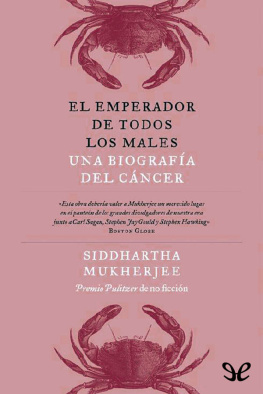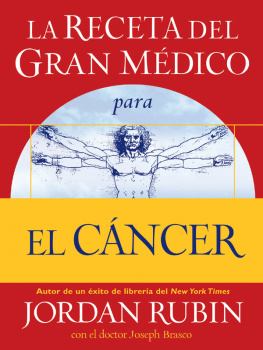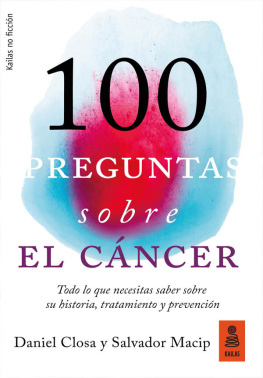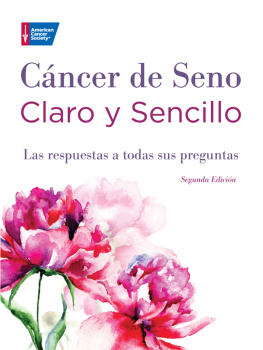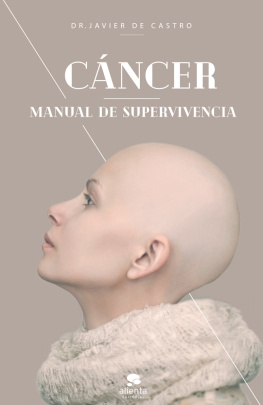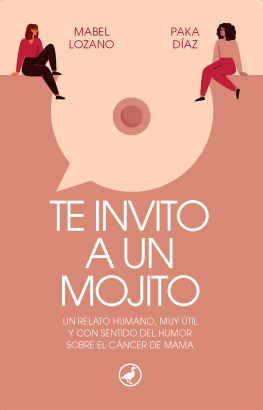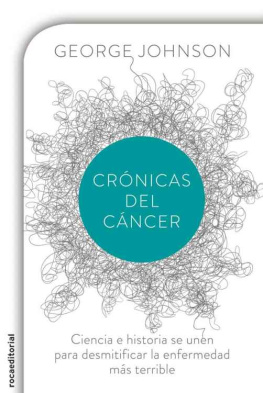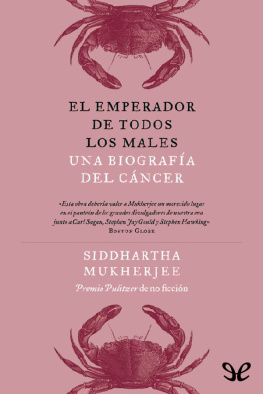Una portentosa biografía del cáncer, hermosamente escrita y ganadora del Premio Pulitzer
¿En qué punto nos encontramos en nuestra batalla contra el cáncer? ¿Cómo ha evolucionado nuestra idea de la enfermedad a través del tiempo y de qué manera han influido los cambios en su trayectoria? ¿Estamos cerca de encontrar «la cura»? ¿Cuál es su verdadera biografía?
El cáncer es una enfermedad que ocupa un complejo espacio social, cultural y político. Su historia no debe contarse sólo como un ensayo científico sino también como un relato profundamente humano.
Con un estilo de alta divulgación, Mukherjee analiza el cáncer como uno de los problemas más graves que han afectado a la humanidad desde sus inicios y, particularmente, en los últimos trescientos años. Ofrece una mirada al futuro de esta enfermedad y un punto de vista nuevo y audaz sobre la manera en que doctores, científicos, filósofos y ciudadanos han observado y entendido el cuerpo humano durante milenios.

Siddahartha Mukherjee
El emperador de todos los males
Una biografía del cáncer
ePub r1.0
Titivillus 01.08.17
Título original: The emperor of all maladies
Siddahartha Mukherjee, 2011
Traducción: Horacio Pons
Editor digital: Titivillus
ePub base r1.2

A Robert Sandler (1945-1948)
y a quienes vinieron antes y después de él
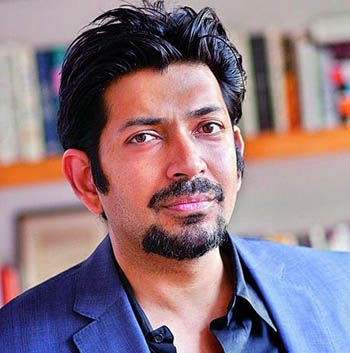
SIDDHARTA MUKHERJEE es profesor de medicina en la Universidad de Columbia en Nueva York, y oncólogo en su hospital universitario. Ganador de una beca Rhodes, se graduó en la Universidad de Stanford y en la Universidad de Oxford, para licenciarse en medicina en la Universidad de Harvard. Ha publicado artículos en Nature, The New England Journal of Medicine, The New York Times y The New Republic. Vive en Nueva York con su esposa y sus hijas.
[526] Rose Kushner, «Is Aggressive Adjuvant Chemotherapy the Halsted Radical of the ’80s?», CA: A Cancer Journal for Clinicians, 34 (6), 1984, pp. 345-351.
[527] Georg Wilhelm Friedrich Hegel, The Phenomenology of Mind, Nueva York, Humanities Press, 1971, p. 232 [Hay trad. cast.: Fenomenología del espíritu, México, Fondo de Cultura Económica, 1966].
[528] James D. Hardy, The World of Surgery, 1945-1985: Memoirs of One Participant, Filadelfia, University of Pennsylvania Press, 1986, p. 216.
[529] Mickey Goulian, entrevista con el autor ya citada.
[530] Stewart Alsop, Stay of Execution: A Sort of Memoir, Nueva York, Lippincott, 1973, p. 218.
[531] Kathleen R. Gilbert (ed.), The Emotional Nature of Qualitative Research, Boca Ratón (Florida), CRC Press, 2001.
[532] Gerda Lerner, A Death of One’s Own, Nueva York, Simon and Schuster, 1978, p. 71.
[533] «Cancer Ward Nurses: Where “C” Means Cheerful», Los Angeles Times, 25 de julio de 1975.
[534] S. Alsop, Stay of Execution…, op. cit., p. 52.
[535]Ibid., p. 84.
[536] Barnett Rosenberg, Loretta Van Camp y Thomas Krigas, «Inhibition of Cell Division in Escheridia coli by Clectrolysis Products from a Platinum Electrode», Nature, 205 (4972), 1965, pp. 698-699.
[537] Larry Einhorn, entrevista con el autor, noviembre de 2009. Véanse también Kathy Latour, «Cured: The John Cleland Story», Cure, 3 (4), invierno de 2004; Craig A. Almeida y Sheila A. Barry, Cancer: Basic Science and Clinical Aspects, Hoboken (Nueva Jersey), Wiley-Blackwell, 2010, p. 259; Tristan Emery, «Survivor Milks Life for All It’s Worth», Purdue Agriculture Connections, 15 (2), primavera de 2006, y «John Cleland Carried the Olympic Torch in 2000 When the Relay Came through Indiana», Friend 4 Cures,
[538] K. Latour, «Cured…», op. cit.
[539] Larry Einhorn, entrevista con el autor ya citada.
[540]Ibid.
[541]Ibid. Véase también Arthur Allen, «Triumph of the Cure», Salon, 29 de julio de 1999,
[542] Margaret Edson, Wit, Nueva York, Dramatists Play Service, 1999.
[543]Ibid., p. 28.
[544] Howard E. Skipper, «Cancer Chemotherapy Is Many Things: G. H. A. Clowes Memorial Lecture», Cancer Research, 31 (9), 1971, pp. 1.173-1.180.
[545] Monroe E. Wall y Mansukh C. Wani, «Camptothecin and Taxol: Discovery to Clinic–Thirteenth Bruce F. Cain Memorial Award Lecture», Cancer Research, 55 (4), febrero de 1995, pp. 753-760, y Jordan Goodman y Vivien Walsh, The Story of Taxol: Nature and Politics in the Pursuit of an AntiCancer Drug, Cambridge, Cambridge University Press, 2001.
[546] Federico Arcamone et al., «Adriamycin, 14-Hydroxydaimomycin, a New Antitumor Antibiotic from S. Peucetius var. caesius», Biotechnology and Bioengineering, 11 (6), 1969, pp. 1.101-1.110.
[547] C. A. J. Brouwer et al., «Long-Term Cardiac Follow-Up in Survivors of a Malignant Bone Tumor», Annals of Oncology, 17 (10), 2006, pp. 1.5861.591.
[548] A. M. Arnold y J. M. A. Whitehouse, «Etoposide: A New Anti-Cancer Agent», The Lancet, 318 (8252), 24 de octubre de 1981, pp. 912-915.
[549] Hamao Umezawa et al., «New Antibiotics, Bleomycin A and B», Journal of Antibiotics, 19 (5), 1966, pp. 200-209; Nuno R. Grande et al., «Lung Fibrosis Induced by Bleomycin: Structural Changes and Overview of Recent Advances», Scanning Microscopy, 12 (3), 1996, pp. 487-494, y Roger S. Thrall et al., «The Development of Bleomycin-Induced Pulmonary Fibrosis in Neutrophil-Depleted and Complement-Depleted Rats», American Journal of Pathology, 105 (1), octubre de 1981, pp. 76-81.
[550] George Canellos, entrevista con el autor ya citada.
[551] John Ziegler, Ian T. Magrath y Charles L. Olweny, «Cure of Burkitt’s Lymphoma–Ten-Year Follow-Up of 157 Ugandan Patients», The Lancet, 314 (8149), 3 de noviembre de 1979, pp. 936-938. Véase también John Ziegler et al., «Combined Modality Treatment of Burkitt’s Lymphoma», Cancer Treatment Report, 62 (12), 1978, pp. 2.031-2.034.
[552] Muchos de estos ensayos auspiciados por el NCI se llevaron a cabo en Uganda, donde el linfoma de Burkitt es endémico entre los niños.
[553] George Canellos, entrevista con el autor ya citada.
[554] «Cancer: The Chill Is Still There», Los Angeles Times, 20 de marzo de 1979.
[555] J. Russell Geyer et al., «Eight Drugs in One Day Chemotherapy in Children with Brain Tumors: A Critical Toxicity Appraisal», Journal of Clinical Oncology, 6 (6), junio de 1988, pp. 996-1.000.
[556] «Some Chemotherapy Fails Against Cancer», The New York Times, 6 de agosto de 1985.
[557] Rose Kushner, «Is Aggressive Adjuvant Chemotherapy the Halsted Radical of the ’80s?», 1984, borrador 9, Rose Kushner Papers. La frase fue eliminada en la versión final publicada en 1984.
[558] M. Edson, Wit, op. cit., p. 31.
[559] Sunzi, The Art of War, Boston, Shambhala, 1988, p. 82 [Hay trad. cast.: El arte de la guerra, Madrid, Trotta, 2001].
[560] Luis H. Toledo-Pereyra, «Discovery in Surgical Investigation: The Essen ce of Charles Brenton Huggins»,

